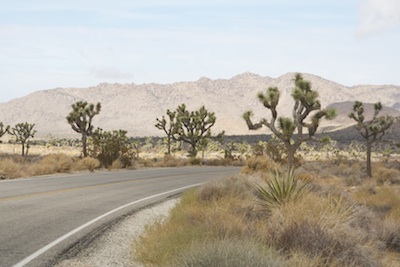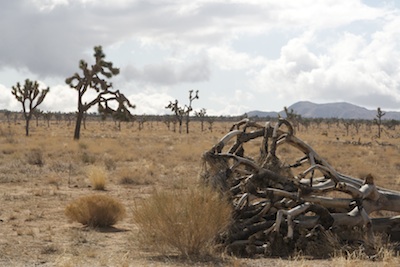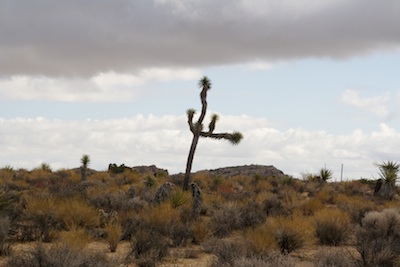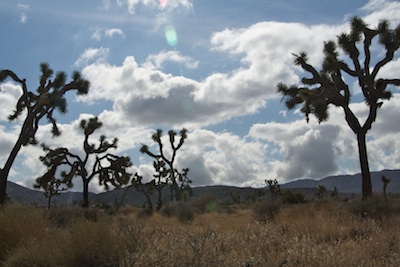
Unusual Joshua tree often surprises visitors
TWENTYNINE PALMS, Calif. – It reminds me of a makeup brush. If you’ve ever seen the L’Oreal brand Telescopic Explosion mascara, you’ll notice it is distinct, unusual and unlike other mascaras in the industry. The brush on this particular product is in the shape of a ball instead of the traditional approximate inch-long cylinder-shaped brush one will usually find.
I tried to conceal the ridiculousness of the first thing I thought of upon my arrival at Joshua Tree National Park, particularly at the sight of the first Joshua tree I drove past. But the resemblance was uncanny — the Joshua tree looked like the prototype to which the telescopic explosion mascara was copied.
Esther Pang, a visitor from Hong Kong, thought the Joshua tree was a deformed cactus.
| Joshua trees (Yucca brevifolia) line a road at Joshua Tree National Park in Twentynine Palms, Calif. (Photos by: Rachel Hartman). |  |
“Then I was like, ‘oh, it’s a tree, sort of.’ Looks nothing like any tree I’ve ever seen,” Pang reacted upon her first encounter with the Joshua tree, which is the namesake of the national park located near here.
“They look like a bunch of trees that were about to bloom and then just stopped,” visitor Stephanie Beyl said as we drove past more and more trees through the park.
On a more serious note, the Joshua tree is indeed mysterious. At first look, the Yucca brevifolia (the Joshua tree’s proper name) appears to be a palm tree of sorts. When one looks closer, you’ll notice that the tree from the yucca family has bark and although the leaves of the tree look like those of a sort of palm or spikes like a cactus, characteristics of the tree itself determine that it is indeed in the yucca family.
When you see a Yucca brevifolia, you can be assured you are somewhere in the boundaries of the Mojave Desert. Joshua trees are exclusive to the southwestern United States; they can be found in California, Utah, Nevada and some parts of Arizona.
 |
At left, a dead Joshua tree lies in a field at Joshua Tree National Park. Below, one of the more simple Joshua trees in the park with only few branches at Joshua Tree National Park. |
“Each tree is totally different,” explained Park Ranger Josh Pelham. “Depends on how the weather treats it. Once they bloom they start branching out.”
Park Ranger Pelham who is stationed at the Oasis Visitors Center of the park commented on why the appearance of Joshua trees is so vast.
Some trees are more intricate with many branches and others are simpler with few branches sometimes far apart. And while some of the Joshua trees are strong and stand straight up, others have wilted or fallen almost completely over.
“It’s the wind. The branches act like huge sails… especially when they start getting branches the wind will tend to act like sails and start bending over,” Pelham said.
Because Joshua trees are top-heavy, the winds in the certain parts of the Mojave Desert cause the branches and leaves to catch the most wind, which is why the trees bend over so much in some cases.
In the depths of the valleys in Joshua Tree National Park, many trees stand straight because of the rock formations that protect the trees and other wildlife. Consequently, due to extreme winds in some of the more barren areas, the Joshua trees and other taller plants are wind-blown and tilted over.
 Because the Joshua tree doesn’t have actual rings, it is difficult to determine the trees’ ages. The trees are said to live anywhere from 75 to 300 years, depending on weather conditions.
Because the Joshua tree doesn’t have actual rings, it is difficult to determine the trees’ ages. The trees are said to live anywhere from 75 to 300 years, depending on weather conditions.
While the palm oases benefit from the extreme heat in the desert, the Joshua tree is a cold desert plant and actually requires more water than one would think — about six to seven inches a year on average.
The stumps of the trees consist of fibers that act like sponges. The sponge-like fibers require more water to thrive in the desert.
“Yucca fiber is amazingly strong. In summertime, we actually play tug-o-war with it. It works really well.”
But while the Joshua trees components may be strong, there are still misfortunes that have come upon this species in recent decades.
“They’re a very sensitive species,” Joe Zarki, chief of Interpretation, said of the ‘Josh trees.’ “They don’t have a huge temperature tolerance. They won’t grow in areas where the temperature is 20 degrees less than what it’s supposed to be.”
Similarly, the Joshua trees won’t grow if temperatures in the desert exceed 100 degrees, despite the fact that they’re desert plants. Joshua trees grow between elevations of 3,000 to about 6,000 feet which makes the national park an idea location for the trees to thrive.
There are no Joshua trees at the park where elevation levels are below 1,000 feet; it can be too hot or too dry, which leaves only about 100,000 acres of JTNP’s 700,000 to 800,000 acres where Joshua trees can grow. At higher elevations, where the temperatures are cooler, Joshua trees cannot grow, either.
With Los Angeles, Las Vegas and Palm Springs metropolitan areas relatively close to Joshua Tree National Park, air pollution has inevitably become an issue for the park and its wildlife.
Years ago, when these cities were not as developed as they are now, climate change was not a problem in the foreseeable future. Today, park officials are concerned with climate change. It is real and relevant.
After all, the park’s namesake could someday cease to exist in the park one day, a worry similar to the park managers at Glacier National Park in Montana.
 |
A group of Joshua trees in a field at Joshua Tree National Park. |
In climate change patterns, if the prediction of temperatures climbing seven to eight degrees is indeed the case, the Joshua trees will have genuine problems growing in the future.
“[The trees] could just disappear from the park,” explained Zarki. “That may happen very quickly… maybe in 100 years or so.”
“It’s a big concern for us and we’re trying to get some research projects up and going. There have been some studies every year on Josh trees, looking at different things,” said Zarki.
Population densities, are among these studies where scientists will count Joshua trees in a given area, go back after a certain period of time to see the changes. Over a 40 to 50 year period, the greatest densities occurred after the 1960s.
Zarki said the flip side of this change is that the national park has a very complex landscape.
“There are a lot of valleys, north-facing slopes and a lot of microhabitats out there,” said Zarki, who can only speculate about changes at this point but is hopeful that the Joshua trees can adapt to the different environments that make up the national park over time.
If You Go
- And you’re adventurous, stay at one of the many campgrounds Joshua Tree National Park has to offer.
- Bring lunch to the picnic area at Hidden Valley then hike the trail.
- Rock climbing is one of the main attractions of Joshua Tree. If you’re experienced, bring your gear and explore.
- Be sure to always have plenty of water with you (the park recommends one gallon of water per person, per day) comfortable shoes, and sunscreen.
- At night, drive into the park and go stargazing. Pam Tripp and other park present stargazing tours at both the Cottonwood Campground and at the Oasis Visitor Center. Check with the park for dates on these excursions.
- Bike riding through the park is permitted and encouraged.
- There are plenty of nature walks of all distances and difficulties to witness the vast wildlife of Joshua Tree such as birding and wildflower viewing. Visit http://www.nps.gov/jotr/planyourvisit/ntrails.htm for a list of these trails and what you’ll get to see at each site.

Comments are Closed